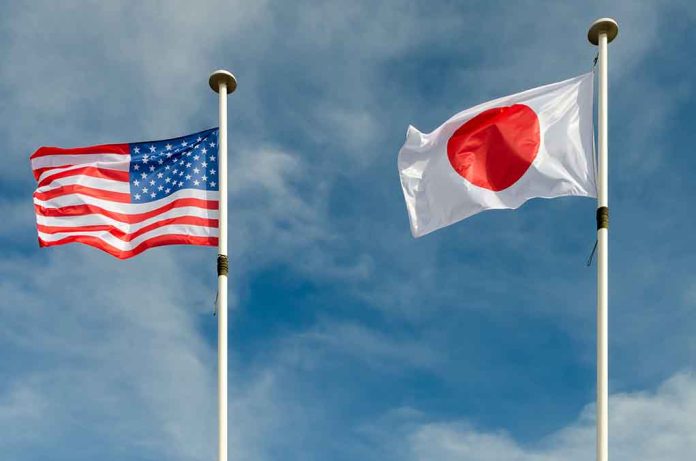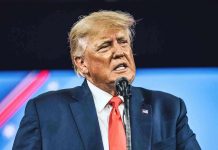
Japan faces a double squeeze as the Trump administration demands both increased military spending and concessions on tariffs, forcing Tokyo to navigate a precarious economic tightrope to maintain its critical alliance with the United States.
Key Takeaways
- The Trump administration is pressuring Japan to increase its $1.45 billion annual contribution for hosting U.S. troops while simultaneously imposing significant tariffs on Japanese imports.
- Japan currently faces a 10% baseline tariff and a 25% tax on cars, auto parts, steel, and aluminum, despite having a longstanding alliance with the U.S.
- Japanese officials acknowledge the connection between defense spending and trade negotiations, with potential military purchases possibly offsetting trade imbalances.
- Japan plans to double its defense spending to 2% of GDP by 2027, but Trump may push for 3%, creating additional financial pressure on the Japanese economy.
- President Trump is personally involved in high-level negotiations with Japan, emphasizing his commitment to reducing America’s $68.5 billion trade deficit with the country.
Military Cost Sharing Demands
The Trump administration has formally requested Japan increase its financial contribution for hosting American troops stationed on Japanese soil. Japan currently covers approximately 211 billion yen ($1.45 billion) annually for U.S. forces. The proposed increase would primarily fund infrastructure improvements including upgraded barracks, family housing, administrative buildings, and disaster prevention facilities for American military personnel stationed throughout Japan. This request comes as Prime Minister Shigeru Ishiba’s government already faces pressure to meet its NATO-style commitment to increase defense spending to 2% of GDP by 2027.
“Hopefully something can be worked out which is good (GREAT!) for Japan and the USA!” said Donald Trump
Trade Tariffs as Leverage
Concurrent with military spending demands, the U.S. has imposed sweeping tariffs that severely impact Japan’s export-driven economy. While temporarily spared from the full 24% tariffs imposed on April 2, Japan still faces a 10% baseline tariff and 25% taxes on cars, auto parts, steel, and aluminum. These tariffs come despite Japan’s average tax rate on other countries’ goods being just 1.9% and its long history as a steadfast American ally. The Trump administration is strategically using these tariffs as leverage to address the $68.5 billion trade deficit with Japan and secure greater market access for American products.
“The level of tariff increases announced so far is significantly larger than anticipated, and the same is likely to be true of the economic effects which will include higher inflation and slower growth,” said Jerome Powell
High-Stakes Negotiations
President Trump has elevated these negotiations to the highest level, personally joining talks with Japanese officials at the White House alongside Treasury Secretary Scott Bessent and Commerce Secretary Howard Lutnick. This direct presidential involvement underscores the strategic importance the administration places on restructuring the U.S.-Japan economic relationship. Japan’s Economic Revitalization Minister Ryosei Akazawa is leading negotiations for Tokyo, tasked with the difficult balancing act of protecting Japan’s economic interests while maintaining the critical security alliance with the United States.
“I am prepared for the talks,” said Ryosei Akazawa
The Defense-Trade Connection
Japanese officials have acknowledged the intertwined nature of defense spending and trade negotiations despite public statements attempting to separate the issues. Akazawa specifically noted that purchasing American defense equipment could impact the U.S. trade surplus with Japan, potentially influencing tariff discussions. This recognition reveals Japan’s strategic approach to negotiations – potentially increasing defense spending and military procurement from U.S. manufacturers to offset trade imbalances and ease tariff pressures. The upcoming visit by Akazawa to the United States will be critical in determining whether this approach succeeds.
Regional Implications
As Japan navigates these complex negotiations, China is capitalizing on the situation, with President Xi Jinping promoting China as a reliable alternative trade partner in Southeast Asia. The pressure on Japan comes at a time when regional security concerns are heightened, particularly regarding China’s assertiveness and North Korea’s nuclear program. Japan’s ability to maintain its defense commitments while managing new tariff burdens has significant implications for regional stability and the broader Indo-Pacific security architecture that the United States has carefully cultivated over decades.
Domestic Challenges
Japan has established a governmental task force to assess the impact of U.S. tariffs and offer loans to affected companies, recognizing the potential damage to its export-driven economy. Meanwhile, Prime Minister Ishiba must balance increasing defense expenditures with Japan’s already strained public finances and a stagnant economy. The pressure to increase military spending from 2% to potentially 3% of GDP would represent a dramatic shift in Japan’s post-war budgetary priorities and could face domestic political resistance. These concurrent pressures create a challenging environment for Japanese policymakers as they prepare for what could be the most consequential U.S.-Japan negotiations in decades.



